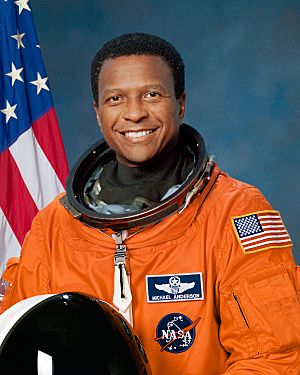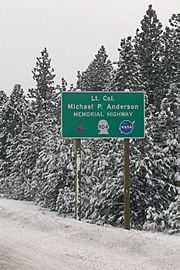Michael P. Anderson facts for kids
Quick facts for kids
Michael P. Anderson
|
|
|---|---|

1995 portrait
|
|
| Born |
Michael Phillip Anderson
December 25, 1959 Plattsburgh, New York, U.S.
|
| Died | February 1, 2003 (aged 43) Over Texas, United States
|
| Alma mater |
|
| Awards | Congressional Space Medal of Honor |
| Space career | |
| NASA astronaut | |
|
Previous occupation
|
Pilot, scientist |
| Rank | Lieutenant colonel, U.S. Air Force |
|
Time in space
|
24d 18h 08min |
| Selection | 1994 NASA Group 15 |
| Missions | STS-89, STS-107 |
|
Mission insignia
|
|
Michael Phillip Anderson (born December 25, 1959 – died February 1, 2003) was a brave officer in the United States Air Force and a NASA astronaut. He was one of seven crew members who sadly died in the Space Shuttle Columbia disaster. This happened when the spacecraft broke apart as it was returning to Earth's atmosphere. Michael Anderson was the payload commander on the Columbia mission. This meant he was in charge of all the science experiments. After his death, he was given the Congressional Space Medal of Honor for his service.
Contents
Early Life and Education
Michael Anderson was born in 1959. He was the third child and only son of Barbara and Bobbie Anderson. His father worked on jets at Plattsburgh Air Force Base in Plattsburgh, New York. Later, his family moved to Fairchild Air Force Base near Spokane, Washington. Michael considered Spokane his hometown.
He graduated from Cheney High School in Cheney, Washington. In 1981, he earned a degree in physics and astronomy from the University of Washington in Seattle. Later, in 1990, he received a master's degree in physics from Creighton University in Omaha.
Air Force Career
After college, Michael Anderson joined the U.S. Air Force as a second lieutenant. He trained at Keesler Air Force Base in Mississippi. Then, he worked at Randolph Air Force Base in Texas. There, he managed communication systems.
In 1986, he was chosen for pilot training at Vance Air Force Base, Oklahoma. After becoming a pilot, he flew EC-135 planes. These planes were part of the "Looking Glass" airborne command post. He also finished his master's degree during this time.
From 1991 to 1995, he served as an instructor pilot. He taught others how to fly in different squadrons. By December 1994, Anderson had flown for over 3,000 hours. This impressive experience led NASA to select him for astronaut training. He was one of only 19 people chosen from nearly 3,000 applicants.
Special Honors in the Air Force
- Distinguished graduate, USAF Communication Electronics Officers course
- The Armed Forces Communication Electronics Associations Academic Excellence Award
- Undergraduate Pilot Training Academic Achievement Award for Class 87-08 Vance AFB
Becoming a NASA Astronaut
Michael Anderson started at the Johnson Space Center in March 1995. He spent a year training and being evaluated. After this, he became a qualified mission specialist for space flights. He first worked on technical duties in the Astronaut Office. Later, he spent more than 593 hours in space on two Space Shuttle missions.
Space Shuttle Missions
Mission on Endeavour
STS-89 was a mission on the Space Shuttle Endeavour from January 22 to 31, 1998. Michael Anderson was a mission specialist on this flight. It was the eighth time a Shuttle docked with the Russian Mir Space Station. The crew delivered over 9,000 pounds of science equipment, supplies, and water.
During this mission, astronaut Andy Thomas was taken to Mir. Astronaut David Wolf returned to Earth. The mission lasted 8 days, 19 hours, and 47 seconds. The shuttle traveled 3.6 million miles in 138 orbits around the Earth.
Mission on Columbia
The STS-107 mission on the Space Shuttle Columbia took place from January 16 to February 1, 2003. Michael Anderson was the payload commander on this flight. He was in charge of all the science experiments. The Columbia was NASA's oldest shuttle. The crew successfully completed over 80 scientific experiments during their 16-day trip.
Sadly, on February 1, 2003, the shuttle was returning to Earth. It had been damaged during its launch on January 16. A piece of foam from the fuel tank's insulation broke off. It hit the Columbia's left wing and made a hole. When the shuttle re-entered Earth's atmosphere, super-hot gases got into the wing through this hole. This led to the shuttle breaking apart. The mission lasted 15 days, 22 hours, and 20 minutes.
An investigation board looked into the accident. They found that the physical damage to the Columbia caused the disaster. They also noted that some management practices at NASA played a part.
Michael P. Anderson Quotes
- "There's always that unknown."
- "When you launch in a rocket, you're not really flying that rocket. You're just sort of hanging on."
- "As you look back at your life, there are just a million different things that have happened, just in the right way, to allow you to make your dreams come true. And you know, someone has all that under control."
- "It looks like the future's really bright."
- "If you want something that’s going to provide you with a lot of challenges and a variety of different things to do, then you really can’t beat a place like the Air Force."
Personal Life
Michael Anderson was married to Sandra Hawkins. They had two daughters, Kaycee and Sydney. He was also survived by his parents and three sisters.
At the time of his death, Anderson and his family lived in Houston. They attended Grace Community Church, where he sang in the choir.
Awards
 |
|||
| Air Force Command Pilot Astronaut badge | |||
| Defense Distinguished Service Medal † | Defense Superior Service Medal | Meritorious Service Medal | Air Force Achievement Medal with cluster |
| National Defense Service Medal | Congressional Space Medal of Honor † | NASA Distinguished Service Medal † | NASA Space Flight Medal † |
| The † symbol indicates an award given after death. | |||
Legacy and Tributes
Many places and things have been named in honor of Michael P. Anderson:
- Washington State Route 904 was renamed in his memory. This road runs through Cheney, Washington, where he went to high school.
- The science and math wing at Cheney High School is dedicated to him.
- Asteroid 51824 Mikeanderson was named after Anderson.
- Anderson Hall at the Florida Institute of Technology is named after him.
- Anderson Plaza at Creighton University is named in his honor.
- Blair Elementary School on Fairchild Air Force Base was renamed Michael Anderson Elementary School in 2004. He attended this school as a fifth-grader.
- Avondale Elementary School in Avondale, Arizona was also renamed Michael Anderson Elementary. He went to school there in third grade. One of the school's T-shirts was even on the Columbia during its last flight.
- In 2003, he was honored at the International Forest of Friendship in Atchison, Kansas. This was part of a memorial for all the Columbia astronauts.
- Anderson Park in Canton, Mississippi was dedicated in June 2004.
- An outdoor bronze statue of Anderson was revealed in Spokane in June 2005. It shows him kneeling with his helmet and a dove.
- A second statue was placed at the Museum of Flight in Seattle in June 2009. The museum also started an aerospace program in his honor.
- A mural honoring Michael P. Anderson was unveiled in Plattsburgh in October 2020.
- A crater on the Moon, M. Anderson, is named after him.
- The Physics Department at Creighton University has a statue and a scholarship in his honor.
See also
 In Spanish: Michael P. Anderson para niños
In Spanish: Michael P. Anderson para niños




